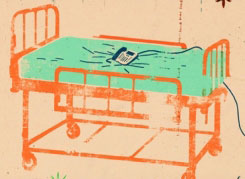Drink and Be Strong
A new study finds that moderate alcohol intake makes for sturdier bones—just don’t hit the hard stuff
Drinking moderate amounts of alcohol has been found to be associated with greater bone mineral density in men and women mostly over age 60, according to a new Tufts study.
Researchers at the Jean Mayer USDA Human Nutrition Research Center on Aging (HNRCA) at Tufts found a positive association between beer and wine and greater bone density, but at the same time noted that bone mineral density was significantly lower in men drinking more than two servings of liquor per day. The results suggest that regular moderate consumption of beer or wine may have protective effects on bone, but that heavy drinking may contribute to bone loss.

Research suggests that regular moderate consumption of beer or wine may have protective effects on bone, but that heavy drinking may contribute to bone loss. Photo: iStock
“Previous research suggests that moderate alcohol consumption in older men and post-menopausal women may protect against bone mineral density loss, a major risk factor for osteoporosis,” says Katherine Tucker, director of the Dietary Assessment and Epidemiology Research Program at the HNRCA. The 2005 dietary guidelines issued by the federal government define moderate alcohol consumption as one drink a day for women and two drinks daily for men.
“Our study also looks at the possible effects of the three alcohol classes, beer, wine and liquor, on bone mineral density,” says Tucker, who is also a professor at the Friedman School of Nutrition Science and Policy. “We saw stronger associations between higher bone mineral density and beer drinkers, who were mostly men, and wine drinkers, who were mostly women, compared to liquor drinkers.” The results were published in late February in the American Journal of Clinical Nutrition.
Tucker, who is also an adjunct associate professor of family medicine and community health at Tufts Medical School, and her colleagues analyzed bone mineral density measurements taken at three hip sites and the lumbar spine in 1,182 men, 1,289 post-menopausal women and 248 pre-menopausal women whose parents or in-laws participated in the original Framingham Heart Study.
There was not enough data to determine the effects of more than two servings of alcohol per day in post-menopausal women or the effects of daily alcohol consumption on bone mineral density in pre-menopausal women. Participants self-reported their alcohol intake on dietary questionnaires. One serving of beer equaled a glass, bottle or can. One serving of wine equaled a 4-ounce glass, and one serving of liquor equaled one mixed drink or shot.
After adjusting for other factors that may have accounted for the higher bone mineral density, such as silicon intake, calcium intake and smoking history, the authors saw an association between higher bone mineral density and moderate alcohol consumption. One of the strongest associations was seen in men who reported consuming one or two servings of total alcohol (a combination of beer, wine and liquor) or one or two servings of beer per day. Hip bone mineral density in this group was significantly greater compared to non-drinkers.
In contrast, the authors observed significantly lower bone mineral density at the hip and spine in men who consumed more than two servings of liquor per day compared to men who consumed one or two servings of liquor per day. “There is a body of research showing alcoholism is devastating to bones,” Tucker says. “It’s a major risk factor for osteoporosis. No one should depend solely on alcohol to maintain bone health.”
The authors hypothesize that the silicon in beer contributed to the higher bone mineral density scores in the men who reported consuming one or two servings of total alcohol or beer per day. Previous studies have found that silicon has greater bioavailability as a liquid. It is less clear why liquor and wine might protect bone mineral density.
“We cannot say definitively what component of these alcoholic drinks might be beneficial to bone health, because our findings are from an observational study as opposed to a clinical trial,” Tucker says. “Future studies might dig deeper into patterns of alcohol consumption, as we relied on a self-reported dietary questionnaire. Another component of data worthy of exploration is whether the antioxidants found in wine, such as revesterol or polyphenols, have a protective effect on bone in addition to other health benefits.”


